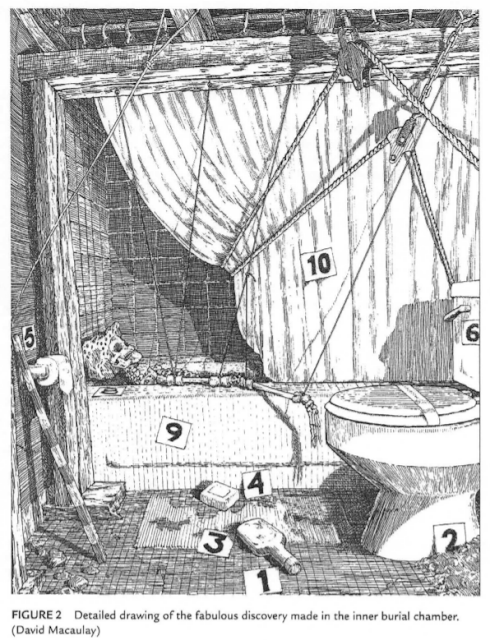How do we know about people who lived in ancient times? The clothes they wore, food they ate, and cultures and lifestyles are questions for archaeologists...
"An archaeologist might find a pot, a grave, or the remains of a building. Each discovery is like a piece of a puzzle. The archaeologist works to put these pieces together to create a picture of what life was like long ago. Like all scientists, archaeologists start with a question they want to explore, such as “Why was this ancient city abandoned?” Then, they gather evidence by digging in the field. Back in the lab, they analyze their evidence. Finally, they share their results with others.
It’s not easy finding the remains of an ancient culture. As years pass, buildings and artifacts get buried under dirt, rubble, or even other settlements. Archaeologists have to dig underground to find these remains. But finding the right place, or “site,” to dig is the first challenge. Archaeologists don’t just dig anywhere. They look for a site they think will help answer their questions about the people or time they are studying.
This takes a lot of planning and research. Before digging begins, archaeologists survey the site, and then create a map of it to help them decide where to dig. There are many kinds of evidence that teach us about the past: majestic pyramids, the ruins of an ancient city, pieces of pottery, even a simple trash pit. Every piece of evidence has one thing in common—it’s lasted a long time.
Most things from the past, like fabric, wood, and food, decay over time. Things made of clay, metal, and stone survive much longer. What survives also depends on the environment. In a rain forest, a wooden spear would rot and decay. But in a desert, the same spear might be preserved by the dry air.
When a site is excavated , it is also destroyed. That’s why it’s so important to keep accurate, detailed records of everything on a site. When archaeologists dig, they create a grid to keep track of where they find things. They also draw pictures and take photographs of everything they find. All this information helps archaeologists re-create a picture of the site later. These records will be shared with other scientists interested in that site.
Many places, like the American Museum of Natural History, collect artifacts from around the world. Scientists use the collections like a library. These collections give people a chance to see artifacts from faraway places and ancient cultures that disappeared long ago."
How well archaeological remains survive is affected primarily by the materials they are made of and the environment in which they may lie for centuries before being discovered. Organic remains are affected by humidity and air and can easily decay. They generally undergo significant decay within a fairly short time unless they are preserved in special conditions. At most sites, fragile artifacts and organic remains are lost to us forever. Examples of organic remains include human, animal, and plant remains and objects and features made of plants and animals.
Inorganic remains survive better, although they can rust, tarnish, or otherwise break down in unstable conditions. Sometimes it is amazing that anything survives at all! Only if a site is covered over and sealed quickly, as Pompeii was by volcanic ash, may both organic and inorganic remains survive. Examples of inorganic remains include clay, stone, cement, plastic, glass, and metal.
Howard Carter & Motel of the Mysteries
The protagonist in this story is Howard Carson, which is a thinly-veiled satire of Howard Carter, the British archaeologist who first excavated the tomb of Tutankhamun. King Tut's tomb was by far the most intact of all the tombs that were excavated, and artifacts were well-preserved, including the sarcophagus and mummy. Because of this discovery, an interest in ancient Egypt and Egyptology was sparked around the world!
The wealth of artifacts and treasures found in King Tut's tomb took decades to excavate. Carter remained in Egypt, working on the site, until the excavation was completed in 1932. He returned to London and spent his later years working as a collector for various museums. The joke of the book - where they take it to the extreme - is the archeologists’ uncritical misinterpretation of the objects they discover. In the absence of testimony, archaeological interpretation is basically just guesswork...which doesn't mean you should entirely discount it, but think on these interpretations with a critical eye.
Read
- Motel of the Mysteries (David Macaulay)
- It is the year 4022; all of the ancient country of Usa has been buried under many feet of detritus from a catastrophe that occurred back in 1985. Imagine, then, the excitement that Howard Carson, an amateur archeologist at best, experienced when in crossing the perimeter of an abandoned excavation site he felt the ground give way beneath him and found himself at the bottom of a shaft, which, judging from the DO NOT DISTURB sign hanging from an archaic doorknob, was clearly the entrance to a still-sealed burial chamber. Carson's incredible discoveries, including the remains of two bodies, one of then on a ceremonial bed facing an altar that appeared to be a means of communicating with the Gods and the other lying in a porcelain sarcophagus in the Inner Chamber, permitted him to piece together the whole fabric of that extraordinary civilization.
- Archaeology for Kids
- Addison Cooke series

Watch
Make / Do
- Study ancient cultures with these online activities!
- Create your own time capsule
- Take an archaeological field trip!
- Historic Jamestowne
- Underwater Archaeology in Vermont
- Underwater Archaeology in Kansas
- Grab some field tools and go for a dig!
- Use a metal detector in your backyard to find forgotten treasure
- Become a Junior Archaeologist
- The author was creative in coming up with alternate uses and meanings for all of the objects found in the Motel of the Mysteries. How do you think he managed to make up the items and still manage to be funny? What other objects might have been included in the text? Would you be able to come up with a similar scenario? Write an essay, coming up with at least three additional items found in the motel.
- Make a list of the furniture and objects in a room at your home. Note whether each object is organic or inorganic. Assume 1,000 years have passed, and the room has not been specially preserved. List what will be left after all the organic materials decay.
- What does your trash say about you? Take a close look inside your trash can and think about the clues it offers about your life.
Vocabulary
- attribute
- cairn
- chronology
- context
- dating
- faunal remains
- post hole
- preservation
- sherd
- stratum
- test pit
- trowel
Think
- Do you think that Macaulay is poking fun at history with the subject matter of this book? Is history simply a theory that has been made into a fact by evidence from a particular era? Explain why or why not.
- Do you think that future civilizations will judge us on the materials we leave behind?
Get the entire World History Bundle!
 Includes ten unit studies (plus a bonus!) covering World History. Each unit addresses a new topic, spanning from Ancient Hawaii to modern-day. There is also a study of archaeological concepts. Each unit has introductory text, which will give the student basic background information about the topic at hand.
Includes ten unit studies (plus a bonus!) covering World History. Each unit addresses a new topic, spanning from Ancient Hawaii to modern-day. There is also a study of archaeological concepts. Each unit has introductory text, which will give the student basic background information about the topic at hand.- There are photographs and illustrations, and we have also included primary documents when available.
- After this text, there are featured videos, which augment the background information and help make the topic more accessible for more visual students.
- You will also find a short list of reading books, including a featured novel that the unit builds upon.
- There are vocabulary words, places, and people to identify.
- Reading comprehension, critical thinking questions, and writing assignments are included.
- We add fun with hands-on activities and extra videos to watch that will bring the era to life.
Product samples: Motel of the Mysteries & Encounter
Includes:- Motel of the Mysteries
- Island Boy
- Encounter
- The Odyssey
- A Loyal Foe
- Indigo Girl
- Gold Rush Girl
- Around the World in 80 Days
- Number the Stars
- To Kill a Mockingbird
- House of the Seven Gables (bonus)





No comments:
Post a Comment
Note: Only a member of this blog may post a comment.